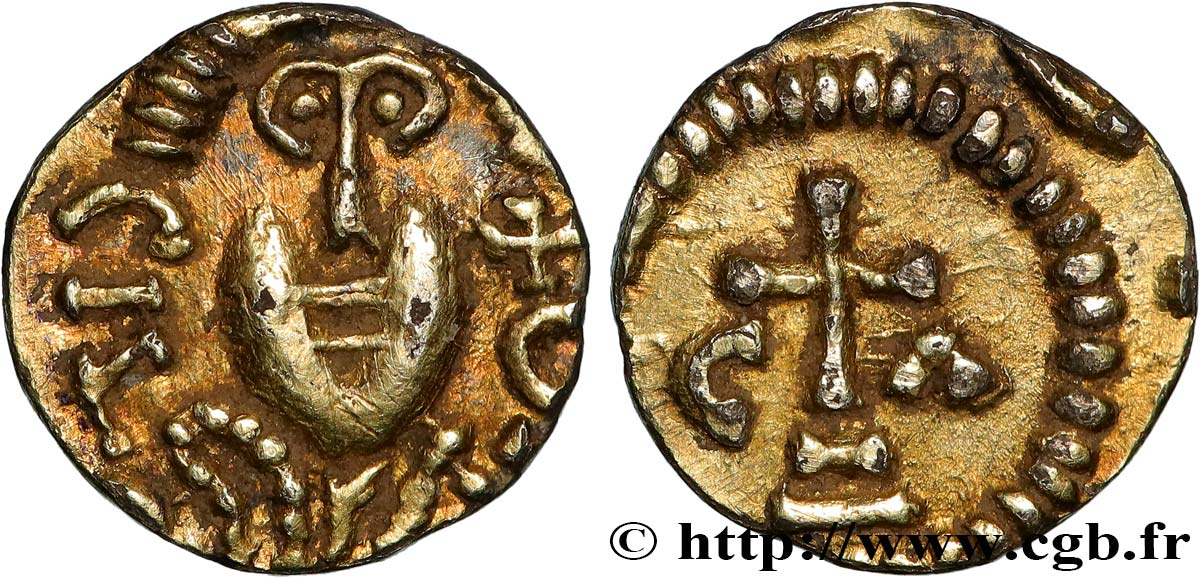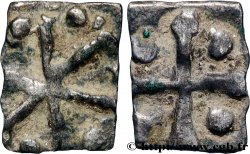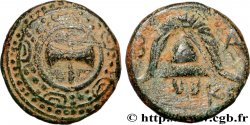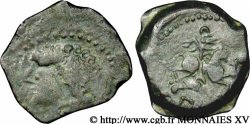bmv_899018 - CHALON - SUR - SAÔNE (CABILONNUM) Triens à la tête de face, groupe VII, fourré
850.00 €约 6944.50 CNY
数量
加入购物车

种类 Triens à la tête de face, groupe VII, fourré
日期: (VIIe siècle)
日期: s.m.
铸币厂名称/城市 Chalon-sur-Saône (71)
材质 gold
直径 10,5 mm
模子方针 12 h.
重量 0,93 g.
稀少度 R3
关于品相的说明
Ce trien est frappé sur un flan irrégulier et a une bonne partie des légendes hors flan. Monnaie fourrée avec une âme cuivreuse recouverte d’or
出版目录中的项代码 :
正面
正面的文字 + CA[...] - CIV.
正面的说明书 Buste de face.
背面
背面的文字 [...].
背面的说明书 Croix latine sur deux degrés, accostée de CA.
评论
Cette monnaie appartient au septième groupe du monnayage mérovingien attribué à Chalon-sur-Saône. Le monnayage de Cabilonnum est divisé en plusieurs groupes. Pour le septième groupe, plusieurs monétaires sont connus ; AVSTADIVS, ABBO, ...ORTVNVS, ALASIVS, MAGNOALDVS, JACOTE D-IC et ED-CDM VSIAS
Pour les monnaies au nom de IACOTEDIC ou JACOTEDIC, les auteurs du Moneta ont étiudié cinq exemplaires ; le Prou 205 de la collection d’Amécourt (repris sous le B. 1247), l’exemplaire de la vente Cahn du 14 décembre 1932, l’exemplaire d’Autun, celui de Montbrisson et enfin le Belfort 1248.
This coin belongs to the seventh group of Merovingian coinage attributed to Chalon-sur-Saône. The coinage of Cabilonnum is divided into several groups. For the seventh group, several coins are known; AVSTADIVS, ABBO, ...ORTVNVS, ALASIVS, MAGNOALDVS, JACOTE D-IC and ED-CDM VSIAS For the coins in the name of IACOTEDIC or JACOTEDIC, the authors of Moneta studied five examples; Prou 205 from the Amécourt collection (reprinted under B. 1247), the example from the Cahn sale of December 14, 1932, the example from Autun, that of Montbrisson and finally Belfort 1248
Pour les monnaies au nom de IACOTEDIC ou JACOTEDIC, les auteurs du Moneta ont étiudié cinq exemplaires ; le Prou 205 de la collection d’Amécourt (repris sous le B. 1247), l’exemplaire de la vente Cahn du 14 décembre 1932, l’exemplaire d’Autun, celui de Montbrisson et enfin le Belfort 1248.
This coin belongs to the seventh group of Merovingian coinage attributed to Chalon-sur-Saône. The coinage of Cabilonnum is divided into several groups. For the seventh group, several coins are known; AVSTADIVS, ABBO, ...ORTVNVS, ALASIVS, MAGNOALDVS, JACOTE D-IC and ED-CDM VSIAS For the coins in the name of IACOTEDIC or JACOTEDIC, the authors of Moneta studied five examples; Prou 205 from the Amécourt collection (reprinted under B. 1247), the example from the Cahn sale of December 14, 1932, the example from Autun, that of Montbrisson and finally Belfort 1248








 对产品描述纠错
对产品描述纠错 打印
打印 分享我的选择
分享我的选择 提问
提问 Consign / sell
Consign / sell
 产品介绍
产品介绍














